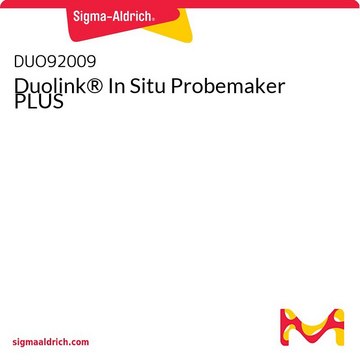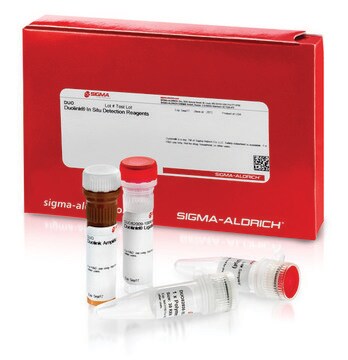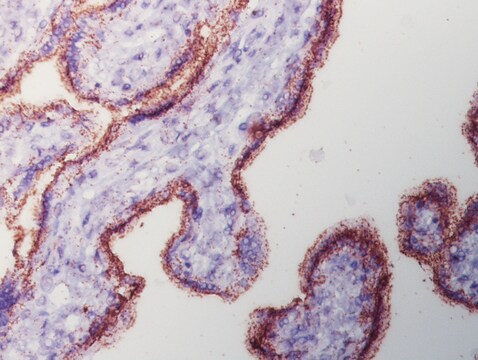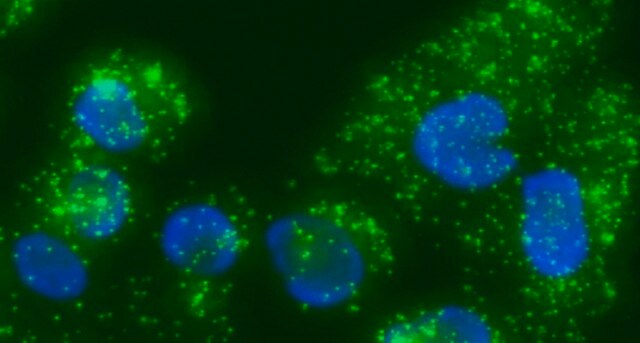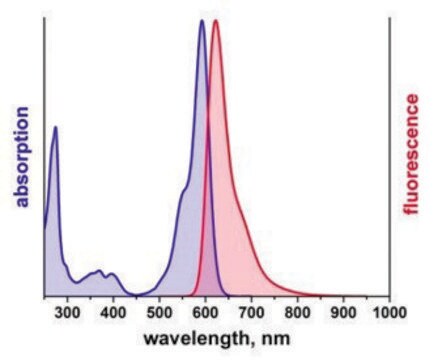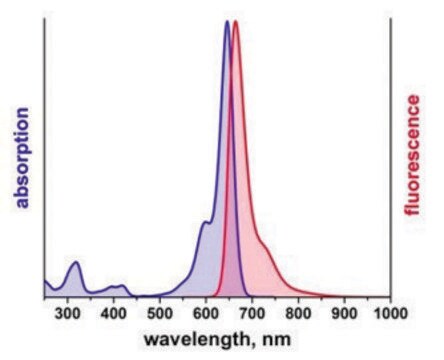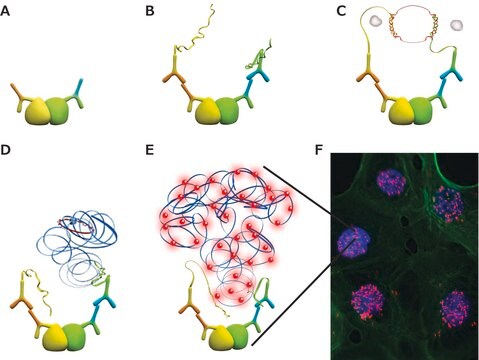Wichtige Dokumente
DUO92010
Duolink® In Situ Probemaker MINUS
Synonym(e):
in situ Proximity Ligation Assay reagent, Protein Protein Interaction Assay reagent
About This Item
Empfohlene Produkte
Produktlinie
Duolink®
Qualitätsniveau
Methode(n)
immunofluorescence: suitable
proximity ligation assay: suitable
Eignung
suitable for brightfield
suitable for fluorescence
Versandbedingung
wet ice
Lagertemp.
−20°C
Verwandte Kategorien
Anwendung
Wir können Ihnen Arbeit abnehmen! lnformieren Sie sich über unser kundenspezifisches Serviceprogramm zur Beschleunigung der Duolink®-Projekte
Sehen Sie sich die vollständige Duolink®-Produktliste an
Specificity
Duolink® In Situ Probemaker extends your possibilities even further by allowing you to create your own PLA probes to meet specific assay requirements.
- Study homodimers
- Study protein-protein interactions with two primary antibodies derived from the same species
- Study protein-protein interactions with primary antibodies from any species
Using Duolink® In Situ Probemaker PLUS and MINUS, you simply conjugate the PLUS and MINUS oligo arms directly to your antibodies in a quick and convenient procedure. As well as providing unique capabilities, this also means there is no longer any limitation as to which species your primary antibodies have to be derived from in order perform a Duolink® In Situ assay.
Application Note
The antibody to be conjugated must have a concentration of 1 mg/ml. Do not use volumes larger than 20 ml for conjugation. The antibody must be in an amine free buffer, ideally PBS. The buffer should be carrier free but may contain up to 0.1% BSA, 5% trehalose, and 0.02% sodium azide.
- Study homodimers by using one monoclonal antibody split into two halves. Label one with the PLUS oligo and the other with the MINUS oligo.
- Use antibodies from same species: study protein-protein interactions, protein modifications, or single proteins, using two primary antibodies derived from the same species. Label one of the antibodies with the PLUS oligo and the other with the MINUS oligo
- Use antibodies from any species: study protein-protein interactions, protein modifications, or single proteins, using one or both primary antibodies derived from species other than mouse, rabbit or goat. Label one of your secondary antibodies with the PLUS oligo and the other with the MINUS oligo. Or, combine one labeled secondary antibody with a standard secondary Duolink® In Situ PLA probe.
Test your primary antibodies (IgG-class, mono- or polyclonal) in a standard immunofluorescence (IF), immunohistochemistry (IHC) or immunocytochemistry (ICC) assay to determine the optimal fixation, blocking, and titer conditions. Duolink® in situ reagents are suitable for use on fixed cells, cytospin cells, cells grown on slide, formalin-fixed, paraffin embedded (FFPE), or tissue (fresh or frozen). No minimum number of cells is required.
Let us do the work for you, learn more about our Custom Service Program to accelerate your Duolink® projects
View full Duolink® product list
Leistungsmerkmale und Vorteile
- Keine Überexpression oder genetische Manipulation erforderlich
- Hohe Spezifität (weniger falsch-positive Ergebnisse)
- Einzelmolekül-Sensitivität durch RCA (Rolling Circle Amplification)
- Relative Quantifizierung möglich
- Keine Spezialgeräte erforderlich
- Schneller und einfacher als FRET
- Höhere Präzision als co-IP
- Publikationsreife Ergebnisse
Komponenten
- Duolink® In Situ Oligonukleotid MINUS – eine Flasche mit lyophilisiertem aktiviertem MINUS Oligonukleotid für eine Konjugation von 20 μg Antikörpern
- Konjugationspuffer – Puffer für die Konjugationsreaktion
- Stoppreagenz – stoppt die Konjugationsreaktion
- Aufbewahrungslösung – Puffer zum Aufbewahren der vorbereiteten PLA-Sonde (Antikörperkonjugat)
- 20x Assayreagenz – Das Reagenz wird der vom Experimentator optimierten Antikörper-Verdünnung hinzugefügt
- Blockierungslösung – blockiert die Probe vor der Färbung mit Duolink ®In Situ
- PLA-Sonden-Verdünnung – Puffer zum Verdünnen der PLA-Sonde (Antikörperkonjugat) auf die endgültige Assay-Konzentration
Sonstige Hinweise
Befolgen Sie für die Verwendung von Duolink®In Situ Probemaker PLUS und MINUS das Duolink®In Situ Probemaker-Protokoll. Dieses Produkt kann je nach verwendeten Detektionsreagenzien sowohl für das Duolink® In-Situ-Fluoreszenzprotokoll als auch für das Duolink® In-Situ-Hellfeldprotokoll angewendet werden. Weitere Informationen finden Sie unter Herstellung individueller (PLA®-) Sonden.
Besuchen Sie unser Duolink® PLA-Informationszentrum, wo Sie Anleitungen zur Durchführung von Duolink® Versuchen, Anwendungen, Fehlerbehebung und mehr finden.
Rechtliche Hinweise
Signalwort
Warning
H-Sätze
Gefahreneinstufungen
Aquatic Chronic 2 - Skin Sens. 1
Lagerklassenschlüssel
10 - Combustible liquids
WGK
WGK 3
Hier finden Sie alle aktuellen Versionen:
Besitzen Sie dieses Produkt bereits?
In der Dokumentenbibliothek finden Sie die Dokumentation zu den Produkten, die Sie kürzlich erworben haben.
Kunden haben sich ebenfalls angesehen
Artikel
Find Duolink references based on the type of method used, post translational modification detected, and research focus.
Support information including tips and tricks, frequently asked questions, and basic troubleshooting.
Things to consider for preparation, setup and execution of the Duolink® assay protocol
Protokolle
Duolink® kits use in situ PLA®, a proximity ligation assay technology, to accurately and objectively quantify individual proteins, and their interactions and modifications in unmodified cells and tissue.
Verwandter Inhalt
Applications to detect, quantify and visualize protein-protein interactions, post-translational modifications and low expression protein detection using proximity ligation assay
Unser Team von Wissenschaftlern verfügt über Erfahrung in allen Forschungsbereichen einschließlich Life Science, Materialwissenschaften, chemischer Synthese, Chromatographie, Analytik und vielen mehr..
Setzen Sie sich mit dem technischen Dienst in Verbindung.